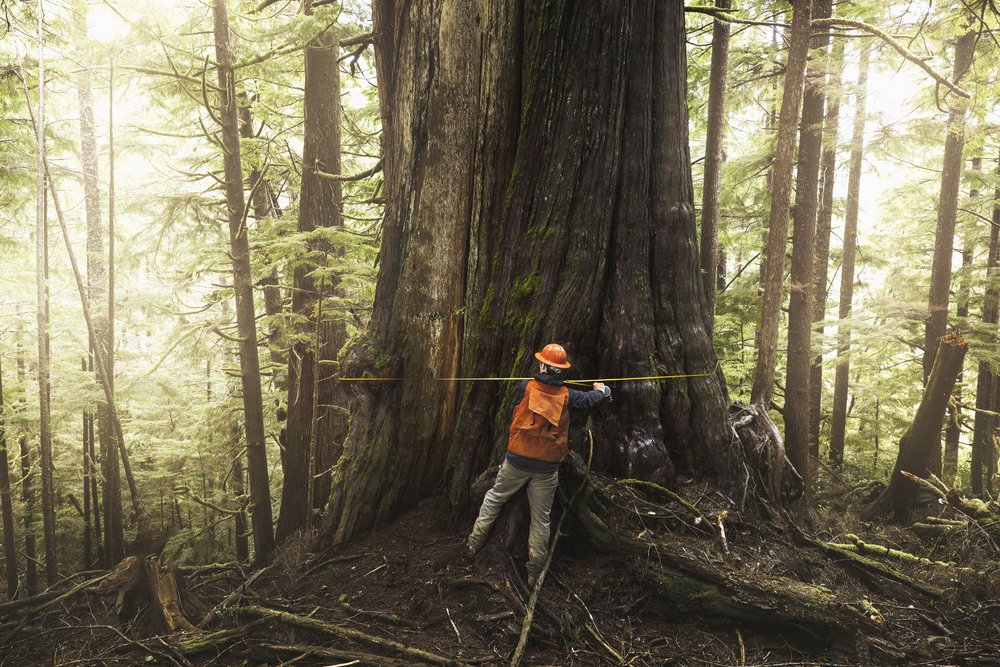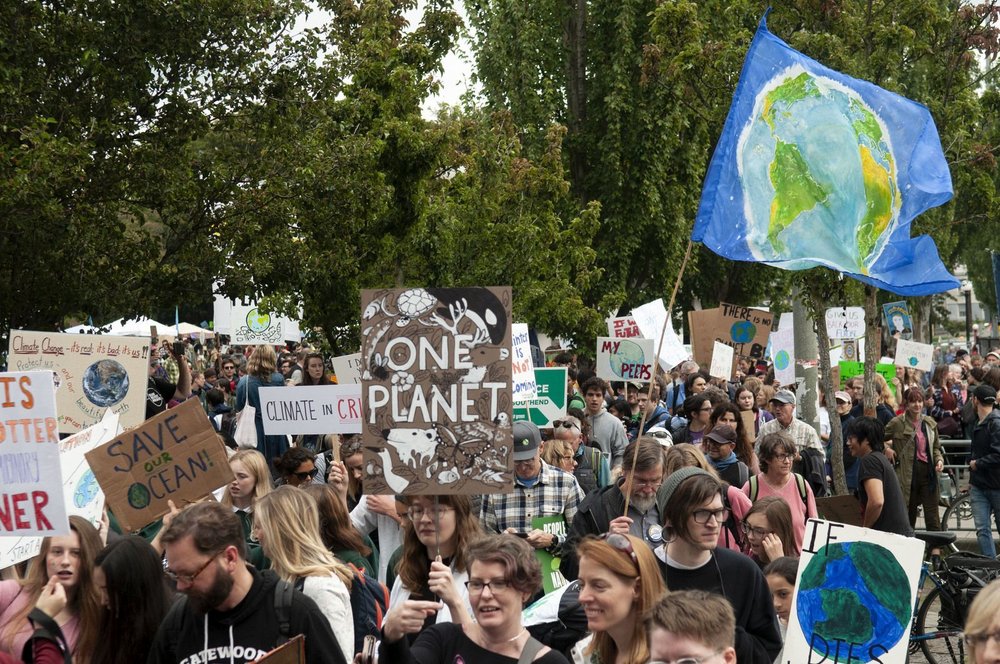Speak up for nature this session
Learn what it means to “Sign in Pro” — one of the quickest, easiest ways to show your support for a bill moving through the Legislature.
Washington’s state Legislature convened today for a 60-day session. In even-numbered years like 2022, lawmakers focus on relatively small budget requests, “fixes” and limited policy proposals. But there’s still a lot happening! Coming off the major successes for nature and people in 2021 – including groundbreaking laws for addressing climate change, working toward environmental justice and increasing wildfire and forest resilience – there’s important work to be done both to ensure these new policies are implemented successfully and to carry forward additional important efforts for an environmentally and socially resilient future for Washington.
Conservancy forester Kyle Smith takes measurements in the old-growth forest at TNC’s Ellsworth Creek Preserve in southwest Washington. Photo by Chris Crisman.
Protecting Natural and Working Lands
In the past two decades, more than a million acres of open space — forests, farmland, ranches and urban tree canopy — have been converted to other uses, damaging fish and wildlife habitat, diminishing our ability to address climate change and negatively impacting human health. Several of our priorities this year seek to stem the loss of irreplaceable natural and working lands and ensure our state is empowered to plan more thoughtfully for the years to come.
-
The Keep Washington Evergreen proposal from the state Department of Natural Resources (DNR) would establish targets and action plans to conserve 1 million acres of working forestland and reforest another million acres of urban tree canopy and recently burned areas by 2040, prioritizing adding trees and green space in overburdened communities. Healthy, resilient and accessible forests promote environmental and community well-being and are one key solution to climate change.
Learn more about Keep Washington Evergreen from DNR
-
Washington’s Conservation Futures program has allowed counties to permanently protect open space, farmland and forests, and to build and maintain parks and trails. But land protection costs have increased significantly over the half-century the program has existed. A limit on annual levy growth means the voter-approved rate is effectively compressed, constraining the ability of Conservation Futures funds to meet local needs. A legislative fix would restore local control over the levy rate, allowing local jurisdictions like counties to better balance conservation and other priorities.
Learn more From THe Conservation Futures COalition
-
A loophole undermining the state Growth Management Act allows counties to subvert the Growth Management Hearing Board appeals process and prematurely permit development that devours or damages farmland, forests and wildlife habitat. Closing the loophole is a top priority for all of us in the Environmental Priorities Coalition.
-
With funding, the Farmland Protection and Land Access program can facilitate the creation of agricultural easements to help prevent conversion of farmland for other uses and assist new and beginning farmers, especially those from underrepresented groups, as they take on ownership and stewardship of agricultural land. We’re supporting a capital budget request from the State Conservation Commission to help this program work in concert with the Farmland Protection and Affordability (FarmPAI) revolving loan fund.
The Klesick family farm in the Skagit Valley exemplifies community-based conservation. Photo by Kelly Compton.
Environmental priorities coalition 2022
Each year, we get together with more than 20 other environmental groups to advocate for a slate of shared priorities. The Lorraine Loomis Act, closing the Growth Management Act sprawl loophole and passing Transportation for All are all on this year’s list.
Salmon Recovery
Despite the best efforts of many across our state, salmon species continue to be threatened and on the brink of extinction. We owe it to ourselves, our neighbors and to future generations — and we are obligated under the federal Endangered Species Act and through treaties with sovereign tribal nations — to recover salmon populations in Washington.
Advocate with the EPC
-
The Lorraine Loomis Act will protect and restore riparian habitat — the trees and plants along riverbanks that help to improve water quality and regulate temperature. Developed through Centennial Accord efforts of treaty tribes and the Governor’s Office, the Lorraine Loomis Act establishes riparian zone standards for landowners in priority watersheds, along with incentives and cost-share provisions.
-
Budget support for salmon recovery efforts is critical, but dedicated funding has been a missing piece of the strategy. We’re advocating for requests in all three supplemental budgets — operating, capital and transportation — to support riparian habitat restoration and protection and clean water, including investing in public-private partnerships to advance innovative green stormwater infrastructure solutions.
Rivers and streams with plenty of vegetation and tall trees alongside them provide good habitat for salmon. Photo of Ellsworth Creek by Bridget Besaw.
Implementing 2021’s big wins
In 2021, the Legislature enacted four important laws marking big progress for addressing climate change (the Climate Commitment Act and Clean Fuel Standard), working toward environmental justice (the HEAL Act) and resilient forest communities (the Wildfire Response, Forest Restoration and Community Resilience Act).
To ensure effective implementation of the Climate Commitment Act (CCA), in 2022 we’re advocating for:
-
enhanced investments for air-quality monitoring in overburdened communities;
-
a specific tribal consultation process for CCA expenditures;
-
the establishment of an Office of Climate Commitment Accountability to govern implementation of the new law;
-
clarification of emissions-reduction pathways for emissions-intensive, trade-exposed industries.
We’ve made a lot of progress, but there’s still much to do. Photo from a pre-pandemic climate march in Seattle by Nikolaj Lasbo.
Community Policy and Budget Priorities
We’re working closely with diverse partners across the state to advocate for strategic investments and policies that make sense for Washington — and make a difference for nature and people. This year, we’re asking the Legislature to:
-
Update the Growth Management Act to help local governments plan for climate change;
-
Expand clean and fair energy infrastructure;
-
Pass a transportation package that invests Climate Commitment Act revenue, federal infrastructure dollars and additional revenue in transportation decarbonization and climate resilience strategies;
-
Prioritize recent federal funding toward safe and clean drinking water;
-
Fund the Sustainable Farms and Fields grant program to help farmers tackle climate change.
